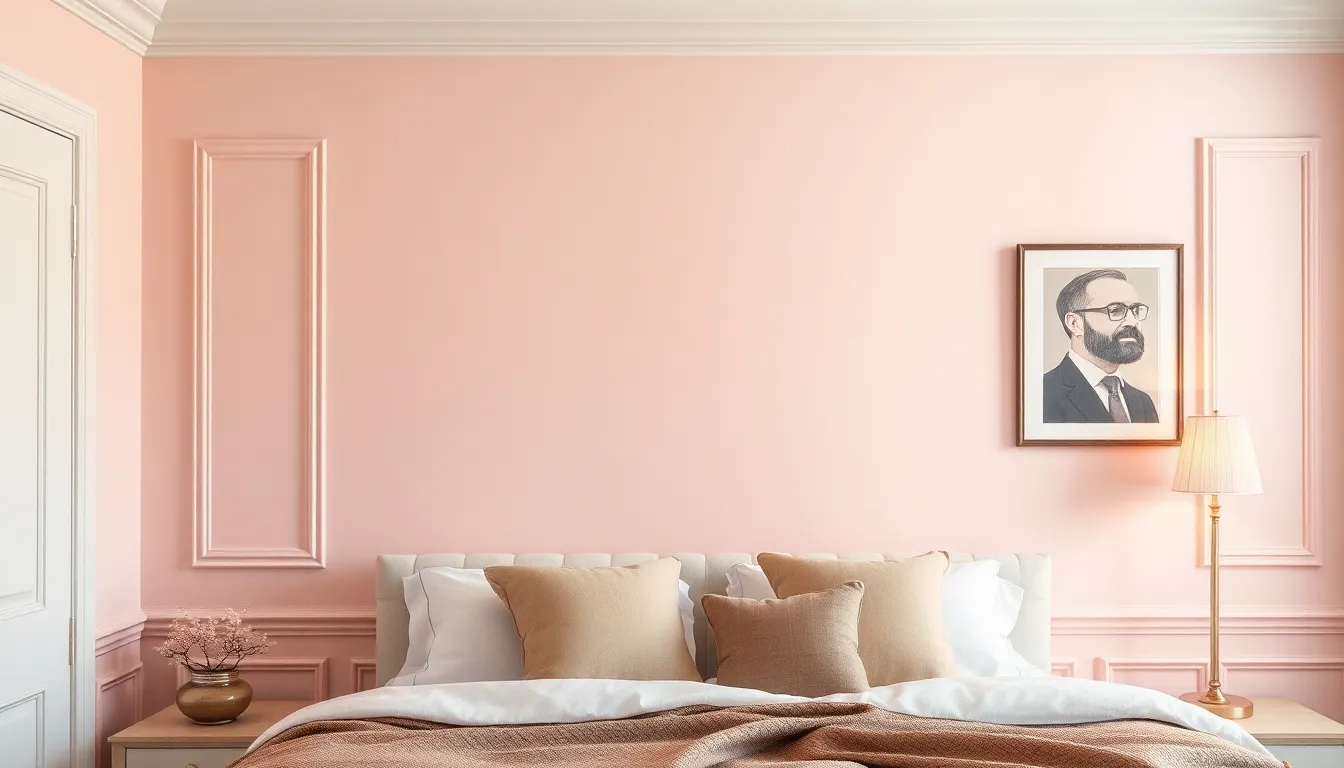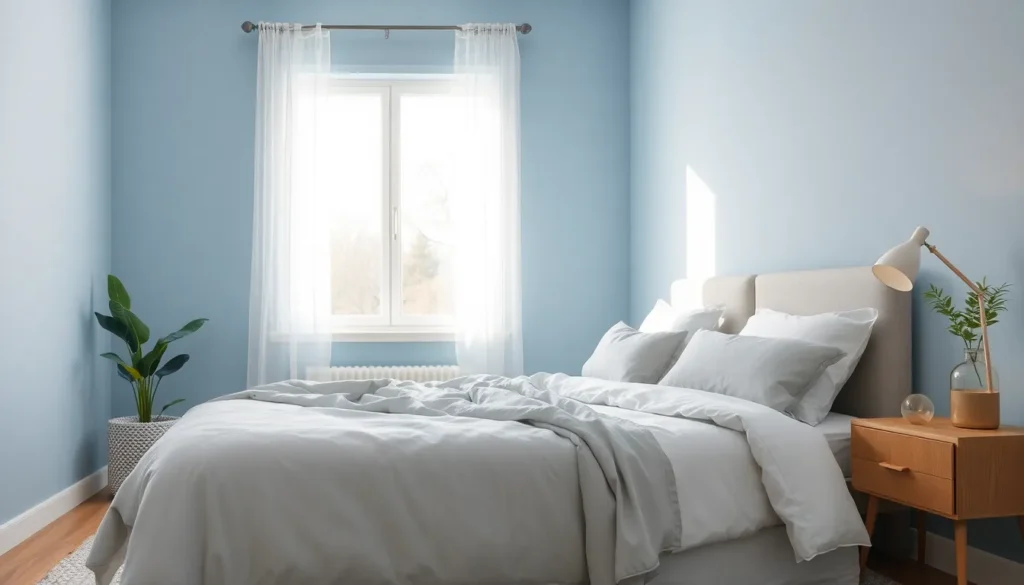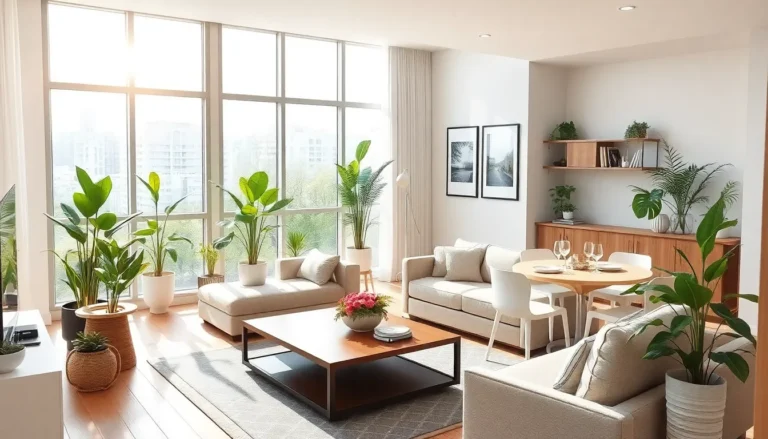Table of Contents
ToggleChoosing the right paint for a bedroom isn’t just about slapping on a color and calling it a day. It’s about creating a sanctuary where dreams take flight and mornings feel a little less like a wrestling match with the alarm clock. With the right hue, a bedroom can transform from a bland box into a cozy retreat, making it the envy of all your friends—even the ones who think they’re too cool for color.
Choosing The Right Paint For Bedrooms
Selecting the right paint for bedrooms transforms a space into a soothing retreat. Various factors influence this choice and understanding color psychology plays a vital role in creating the desired ambiance.
Factors To Consider
Begin with the amount of natural light the bedroom receives. Bright spaces can handle darker colors while dim areas benefit from lighter shades. Room size matters; small rooms often appear larger with pastel hues. Consider the existing furniture and decor as well. Colors should complement these elements for a cohesive look. Lastly, the finish type affects appearance and maintenance. Matte finishes mask imperfections, while glossy options emphasize details.
Color Psychology
Colors impact emotions and perceptions significantly. Blue promotes calmness and relaxation, making it ideal for bedrooms. Green offers a restful environment and connects to nature. Soft yellows evoke cheerfulness, enhancing morning energy. Consider applying muted grays or taupes for sophistication and neutrality. Warm colors like reds and oranges add vibrancy but might be overwhelming. Ultimately, choosing the right colors enhances comfort and supports restful sleep, creating a perfect personal sanctuary.
Types Of Paint Finishes

Choosing the right paint finish significantly influences bedroom aesthetics and functionality. Finishes vary in sheen, durability, and ease of maintenance.
Matte vs. Satin
Matte finishes deliver a non-reflective surface, hiding imperfections well. They suit cozy atmospheres and create a soft, inviting appeal. A satin finish, on the other hand, offers subtle sheen and enhanced durability. Satin is easier to clean, making it ideal for family spaces. For bedrooms, the choice between matte and satin depends on individual preferences for comfort and practicality.
Glossy Options
Glossy finishes shine brightly, reflecting light and adding vibrancy to any room. These paints resist stains and wash easily, appealing for high-traffic areas. Glossy finishes can make colors appear more intense, enhancing the overall look. Though they might not suit a calming bedroom vibe, they work beautifully as accents or in smaller areas. Consider glossy options for trim, furniture, or artwork to achieve a striking contrast with softer wall colors.
Popular Color Schemes
Color schemes play a vital role in creating an inviting bedroom atmosphere. They can evoke specific feelings and enhance personal style.
Neutral Tones
Neutral tones offer versatility and timeless elegance. Shades like beige, taupe, and soft grays provide a calm backdrop, making them ideal for bedrooms. These colors can effortlessly blend with various furniture styles and decor items. Many homeowners use neutral shades to achieve a serene ambiance, allowing for easier accenting with other colors. Layering different neutral tones adds depth, encouraging a visually pleasing environment.
Bold Accent Colors
Bold accent colors bring energy and personality to bedrooms. Vibrant hues such as deep blues, rich reds, or striking greens create focal points, adding interest to the space. Accent walls painted in these shades can dramatically transform the overall look, drawing attention to architectural features or artwork. Pairing bold colors with neutral bases allows for balance, preventing overwhelming visuals. Many designers recommend incorporating bold accents through accessories like throw pillows or artwork to maintain a cohesive look while expressing individuality.
Application Tips
Applying paint in a bedroom involves careful preparation and technique to achieve a flawless finish. Consider the following crucial steps and methods.
Preparation Steps
Begin by clearing the room of furniture and covering the floor with drop cloths. Cleaning the walls ensures optimal paint adhesion, so wipe down any dust or dirt. Fill in holes or cracks with spackle for a smooth surface. Sanding these areas helps create an even texture, allowing the paint to apply seamlessly. Use painter’s tape along edges, doors, and windows to protect areas you don’t want to paint. Consider priming the walls, especially if changing from a dark to a lighter color, to enhance coverage.
Techniques For A Smooth Finish
Use a quality brush for cutting in along the edges and corners of the room. Employ rollers for larger wall areas to ensure even coverage. Work in sections, applying paint in a W pattern to minimize streaks. Wait for the first coat to dry completely before applying a second coat, which helps achieve a rich, saturated color. Maintain a wet edge as you paint to prevent lap marks. During application, keep a consistent pressure on the roller or brush for a professional look.
Maintenance And Touch-Ups
Regular maintenance keeps painted bedroom walls looking fresh and vibrant. Cleaning painted walls helps remove dust, stains, and marks. Use a soft cloth or sponge with mild detergent, avoiding harsh chemicals that can damage the paint finish. Rinsing with clean water ensures no soap residue remains. For stubborn stains, a mixture of baking soda and water works effectively.
Repainting becomes essential when the paint shows signs of wear. Look for fading color, peeling, or chips, as these indicate it’s time for a refresh. High-traffic areas often require more frequent touch-ups. Updating the paint every five to seven years generally maintains the room’s aesthetic appeal. Timing might vary based on the paint type and wall condition, so regular inspections help determine the right moment for a new coat. Keeping a consistent color scheme simplifies future repaints, ensuring a uniform look.
Choosing the right paint for a bedroom is crucial for creating a personal retreat that promotes comfort and tranquility. By considering factors like natural light and existing decor, individuals can select hues that resonate with their emotional needs. The finish of the paint also plays a vital role in achieving the desired atmosphere and practicality.
Regular maintenance and timely touch-ups ensure that the bedroom remains inviting and fresh. With the right approach to color selection and application, anyone can transform their bedroom into a cozy sanctuary that reflects their style and enhances their well-being.







